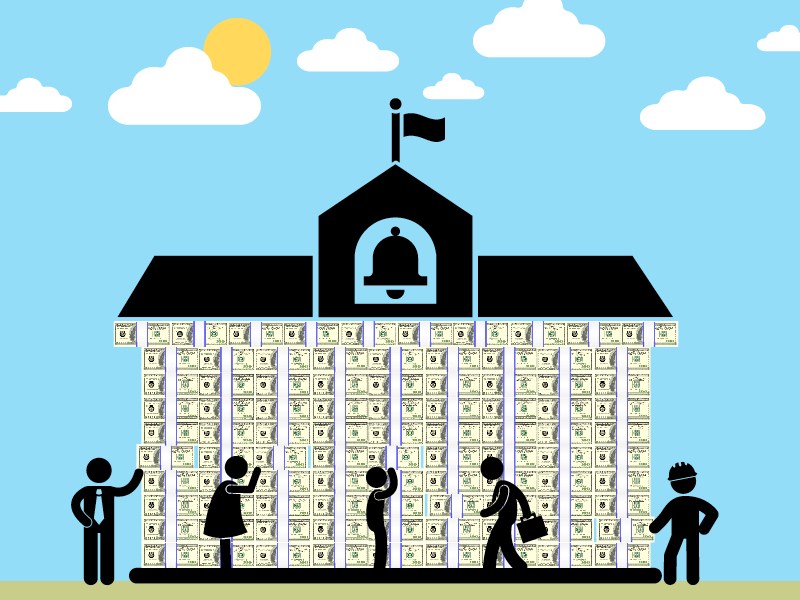State officials say a new Minnesota law tightening licensing requirements for classroom teachers will stave off a threat by the federal Department of Education to cut off $219 million in special education funding.
But some education advocates say that the new law goes too far, and will make it difficult for some teachers of color to stay in the classroom.
The law aims to satisfy a corrective action plan with the U.S. Department of Education’s Office of Special Education Programs. In a May 2023 memo, the federal government warned that Minnesota could lose special education funding if it did not make changes to parts of its licensure system for special education teachers.
The change affects special education teachers with Tier 1 and Tier 2 licenses, which represent alternative pathways to teaching rather than traditional teacher preparation programs. About a quarter of Tier 1 and Tier 2 licenses are held by teachers of color.
The law will require professional development and mentorship of those teachers; progress toward a professional license; and a three-year cap for special education teachers with a Tier 1 license.
“This is good for the teachers, it’s better for kids because these teachers will be supported and prepared,” said Laura Mogelson, the legislative liaison for the Minnesota Association of Colleges for Teacher Education. “We need to keep teachers in longer and stop this revolving door of underprepared teachers.”
RELATED STORIES
But some education advocates say the new bill is too broad.
Josh Crosson, the executive director of education reform group EdAllies, said that while he agreed with OSEP’s direction to the state, the new law went beyond what the federal government required Minnesota to do.
“Our licensing agency keeps changing policies to further and further restrict who can become a teacher, especially in the areas where teacher shortages are the worst,” he said.
A U.S. Department of Education spokesperson said the department was reviewing the legislation to ensure it addressed the “identified noncompliance.” The spokesperson said that the department planned to complete its review by July 1.
Why did the Legislature pass this bill?
In short: to preserve $219 million in annual federal special education funding. Last year, the federal government told Minnesota it could ultimately lose this money if it didn’t change its laws regarding special education teachers.
But the law also aims to make sure special education teachers receive appropriate training.
“We know that our students deserve highly qualified, well-trained teachers, and so we’re hoping this helps ensure that that’s the case,” said Yelena Bailey, executive director of the Minnesota Professional Educator Licensing and Standards Board.
In addition, she said, special education teachers holding a variety of teaching licenses had expressed a desire for more support so they could do their jobs well. “I think this will help provide that.”
About 1 in 5 Minnesota students receive special education services, according to the most recent state data. A disproportionate share of these students are Black and American Indian. Their special education teachers may specialize in disabilities ranging from autism to emotional or behavioral disorders. They are responsible not only for providing instruction, but also keeping students on track with their individualized education plans, tailored for each child’s specific needs and challenges in school.
Federal law requires these teachers to be “appropriately and adequately prepared and trained.” In a memo last May, OSEP Director Valerie Williams told Minnesota Education Commissioner Willie Jett that Minnesota statute and administrative rules were out of compliance with this law.
Williams’ memo emphasized the role of Tier 1 special education teachers. She said these teachers must not remain in that role with that license for more than three years.
What’s a Tier 1 teacher? And how does Minnesota’s teacher licensure system work?
In Minnesota, most teachers earn their licenses through a traditional teacher preparation program. These teachers are eligible for a Tier 3 or Tier 4 “professional” license. These licenses are associated with more job security and eligibility for tenure.
But a person with a bachelor’s degree in any subject and a job offer from a school can also receive a Tier 1 teaching license in Minnesota without completing a traditional preparation program. People who have a master’s degree in a subject area, or who are enrolled in a teacher preparation program but have not completed it, are eligible for a Tier 2 license. Some districts have embraced these licenses as they struggle with teacher shortages — and those shortages have been particularly acute for special education positions.
Some education advocates and school districts have also seen these licenses as a way to diversify the profession. Nearly 40% of Minnesota’s public school students are people of color, but only 6% of their educators are, according to the most recent state data. But that percentage is much higher for Tier 1 and Tier 2 teachers: about a quarter of these educators are people of color.
So where did the federal government identify a problem?
Since Tier 1 teachers can get a license with just a bachelor’s degree and a job offer, they might not have any special education training. So the federal government raised concerns that these teachers were not “appropriately and adequately prepared and trained.”
In a corrective action plan the state submitted to OSEP last July, the Minnesota Department of Education pledged to work with the Legislature to amend the law to limit special education Tier 1 licenses to three years. The department said that 17 teachers statewide exceeded this cap or were at risk of doing so.
The new law, initially proposed in February and passed in May, caps these licenses at three years. It also requires districts or charter schools to affirm that both Tier 1 and Tier 2 teachers are receiving high-quality professional development and intensive supervision or mentorship, and for these teachers to demonstrate “satisfactory progress” toward certification.
“Are you 99% confident that we have met the requirements that the federal government asked us last summer to fix in this bill, and we have addressed all their concerns through this new part of the bill?” Senator Steve Cwodzinski, DFL-Eden Prairie, and chair of the Senate Education Policy Committee, asked when the Minnesota Department of Education introduced the bill in February.
“That was absolutely our intention, Mr. Chair,” replied Megan Arriola, the legislative coordinator for the Minnesota Department of Education.
“That’s music to our ears,” Cwodzinski said.
How will this new law affect teachers?
In practice, the professional development and mentorship requirements will not result in much change for teachers, as the state already requires both, said Paul Dols, a special education workforce development specialist for the Minnesota Department of Education. The new legislative language clarifies existing requirements, he said.
The key change is the three-year limit for Tier 1 special education teachers, said Sonia Smith, director of special education for the Minnesota Department of Education. During that three-year period, the department will be “ensuring that districts are adhering to their responsibility to training and helping to support teachers to move from tier to tier,” she said.
Bailey, the executive director of the state’s teacher licensing board, said that the board had authorized a rulemaking process to outline what “satisfactory progress” toward professional licensure might mean. During the rulemaking process, the public will have an opportunity to weigh in on a proposed definition.
Bailey said that teacher preparation programs attest to whether a teacher is making progress toward licensure. But for teachers who are not enrolled in preparation programs, she said, “we haven’t had a definition of how to look at this.”
She said the state board would likely propose a rule that required teachers to show they are meeting a set of standards, whether they are enrolled in a teacher preparation program or not. But she stressed that this proposal is not set in stone, and that the process would be open to feedback and public comment.
What do education advocates say about the bill?
Mogelson said the Minnesota Association of Colleges for Teacher Education was supportive of the changes for both Tier 1 and Tier 2 teachers.
She pointed to new funding resources that the Legislature passed in 2023 to help special education teachers earn a professional license.
Crosson, the executive director of EdAllies, said he agreed that Tier 1 teachers should receive high-quality professional development and mentorship to continue on the pipeline toward full licensure. But he called the Tier 2 changes an “overreach.”
Crosson said that because of other changes to Minnesota’s tiered licensing system last year, it would be harder for future Tier 1 teachers to advance to Tier 2. And now, changing the requirements for special education would make some prospective teachers more likely to choose a different licensure area, like math, he said.
“I think there are going to be more and more special education classrooms without a teacher,” he said.





